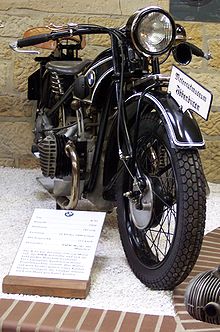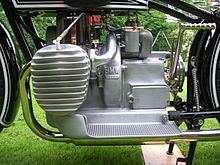BMW R 62
The BMW R 62 was the first touring motorcycle in the 750 cm³ class from the German motorcycle manufacturer BMW.
In the construction period from 1928 to 1929, 4,355 R 62s were produced.
history
development
From July 1928, BMW produced the R 62 for the 750 cm³ class; together with the likewise new and largely identical R 52 for the 500 cm³ class.
BMW continued the modular principle with this motorcycle. The chassis and gearbox with the basic engine were largely identical; The differentiation for the displacement classes with 500 cm³ and 750 cm³ and according to sports and touring models was implemented by two crankshafts with strokes different by 10 mm, matching cylinders with the same bore and head or side-controlled cylinder heads and cylinders.
marketing
The product launch - initially the two touring motorcycles R 52 and R 62 and shortly afterwards the two sports models R 57 and R 63 - took place on a modest scale, because the new models with pressed steel frames were presented at the German Motor Show in November 1928 in Berlin .
When the motorcycle was introduced in 1928, the price was 1650 Reichsmarks; In 1930 the R 62 was still listed in the price list alongside the successor models for 1,450 Reichsmarks, and in 1931 it was still offered for sale in brochures.
Production ended after 4355 units; The successor was the R 11 presented at the end of 1928 .
technology
engine
The engine with the designation M 56 was a longitudinally mounted twin-cylinder boxer - four-stroke engine with flathead engine .
construction
The crankshaft and the two connecting rods ran in plain bearings for the first time; BMW continuously developed the concept of the boxer engine. The motor housing could be divided horizontally. An intermediate gear above the crankshaft drove the camshaft one level higher, which in turn drove the ignition system on the next level. This gear cascade made the engine relatively tall for a boxer engine.
The camshaft opened the valves via short slide tappets.
cylinder
The cast iron cylinders had removable cylinder heads made of light metal and radial cooling fins.
Carburetor
The carburetor, an in-house design by BMW, sucked in the air through the flywheel housing.
The mixture quantity ("throttle slide") and mixture composition ("air slide") were set using two levers on the right-hand handlebar half.
drive
The R 62 had a manual gearbox with a drive shaft on the right side of the unsprung rear wheel.
BMW referred to the power transmission from the gearbox to the rear wheel as a " cardan drive ", the drive shaft as a " cardan shaft " and the gearbox on the rear wheel as a "cardan housing" - technically correct it was only a shaft drive of the rear wheel, as there were no cardan joints.
The horizontally divisible gearbox housing was flanged directly to the motor housing. The three-speed input shaft was driven directly by the single-plate dry clutch in the crankshaft's flywheel. The output shaft drove the drive shaft via a hardy disk in direct extension.
The housing of the bevel gear drive on the rear axle was filled with oil. The gearbox was filled with oil for the first time - on the R 42 it was still lubricated with grease.
The kick starter was actuated at right angles to the vehicle's longitudinal axis; the complex bevel gear redirection in the gearbox housing was no longer necessary.
landing gear

The chassis was a tubular frame without rear suspension, the front fork had a drawn short swing arm with leaf suspension.
The rear brake was designed as a cardan brake that acted on the outer ring of the hardy disc.
Technical specifications
| Parameter | Data of the R 62 |
|---|---|
| drilling | 78 mm |
| Hub | 78 mm |
| Displacement | 740 cc |
| power | 18 hp (13.2 kW ) at 3400 min -1 |
| Top speed | 115 km / h |
| Empty weight | 155 kg |
| total weight | 355 kg |
| Tank capacity | 12.5 liters |
See also
literature
- Udo Stünkel: BMW motorcycles typology: All series models from 1923 . Delius Klasing, Bielefeld 2008, ISBN 978-3-7688-2451-4 .
Web links
- BMW R 62. In: BMW History. BMW AG, accessed on October 16, 2017 (dossier from the BMW Group Archives).
Individual evidence
- ↑ a b Start of production of the motorcycle models R 52, R 62, R 57 and R 63. In: BMW history. BMW AG, July 1928, accessed on December 13, 2015 (document in the BMW Group Archive).
- ↑ Price list No. 45 for BMW motorcycles: R 2, R 52, R 57, R 62, R 11, R 63, R 16. In: BMW History. BMW AG, 1930, accessed on December 13, 2015 (document in the BMW Group Archive): "The particularly powerful sidecar machine for pillion and sidecar touring drivers"
- ↑ BMW's fastest sidecar machine in the world! Touring models: R 52 and R 11, sports models: R 57 and R 16. In: BMW history. BMW AG, April 20, 1931, p. 6 , accessed on January 17, 2016 (document in the BMW Group Archive).
- ↑ Udo Stünkel: BMW motorcycles typology: All series models from 1923 . Delius Klasing, Bielefeld 2008, ISBN 978-3-7688-2451-4 , p. 16-20 .
- ↑ a b Spare parts list and tables for the BMW two-cylinder motorcycles type R 52 and R 62. In: BMW history. BMW AG, July 1930, accessed on December 17, 2015 (document in the BMW Group Archive).
- ↑ a b c d manual for BMW wheels type R 52 and R 62. In: BMW history. BMW AG, June 1928, accessed on December 17, 2015 (document in the BMW Group Archive).
| class | Type | 1920s | 1930s | 1940s | ||||||||||||||||||||
| 3 | 4th | 5 | 6th | 7th | 8th | 9 | 0 | 1 | 2 | 3 | 4th | 5 | 6th | 7th | 8th | 9 | 0 | 1 | 2 | 3 | 4th | 5 | ||
| up to 250 cm³ | Touring motorcycle | R 2 | R 20 | |||||||||||||||||||||
| R 23 | ||||||||||||||||||||||||
| Sport motorcycle | R 39 | |||||||||||||||||||||||
| up to 500 cm³ | Touring motorcycle | R 32 | R 42 | R 52 | R 4 | |||||||||||||||||||
| R 3 | R 35 | |||||||||||||||||||||||
| Sport motorcycle | R 37 | R 47 | R 57 | R 5 | R 51 | |||||||||||||||||||
| up to 750 cm³ | Touring motorcycle | R 62 | R 11 | R 12 | R 71 | |||||||||||||||||||
| R 6 | R 61 | |||||||||||||||||||||||
| Sport motorcycle | R 63 | R 16 | R 17 | R 66 | ||||||||||||||||||||
| Prototypes, racing bikes | R 7 | |||||||||||||||||||||||
| WR 750 | R 51 RS | |||||||||||||||||||||||
| Military motorcycles | R 12 | |||||||||||||||||||||||
| R 75 team | ||||||||||||||||||||||||



